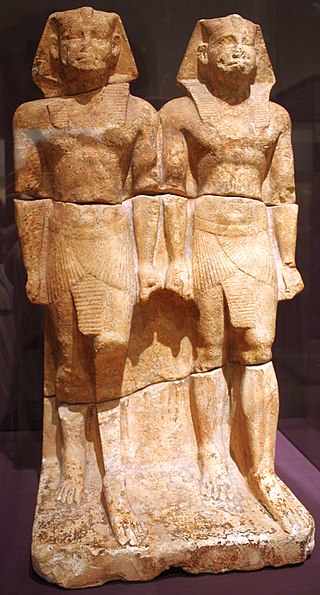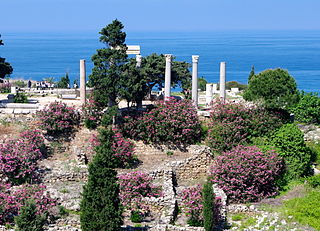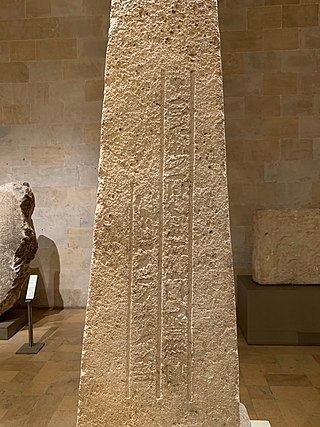
Resheph was a god associated with war and plague, originally worshiped in Ebla in the third millennium BCE. He was one of the main members of the local pantheon, and was worshiped in numerous hypostases, some of which were associated with other nearby settlements, such as Tunip. He was associated with the goddess Adamma, who was his spouse in Eblaite tradition. Eblaites considered him and the Mesopotamian god Nergal to be equivalents, most likely based on their shared role as war deities.

Byblos, also known as Jebeil, Jbeil or Jubayl, is an ancient city in the Keserwan-Jbeil Governorate of Lebanon. The area is believed to have been first settled between 8800 and 7000 BC and continuously inhabited since 5000 BC. During its history, Byblos was part of numerous cultures including Egyptian, Phoenician, Assyrian, Persian, Hellenistic, Roman, Genoese, Mamluk and Ottoman. Urbanisation is thought to have begun during the third millennium BC and it developed into a city making it one of the oldest cities in the world. It is a UNESCO World Heritage Site.

The Sea Peoples were a group of tribes hypothesized to have attacked Egypt and other Eastern Mediterranean regions around 1200 BC during the Late Bronze Age. The hypothesis was first proposed by the 19th century Egyptologists Emmanuel de Rougé and Gaston Maspero, on the basis of primary sources such as the reliefs on the Mortuary Temple of Ramesses III at Medinet Habu. Subsequent research developed the hypothesis further, attempting to link these sources to other Late Bronze Age evidence of migration, piracy, and destruction. While initial versions of the hypothesis regarded the Sea Peoples as a primary cause of the Late Bronze Age collapse, more recent versions generally regard them as a symptom of events which were already in motion before their purported attacks.

Sahure was a pharaoh of ancient Egypt and the second ruler of the Fifth Dynasty. He reigned for about 13 years in the early 25th century BC during the Old Kingdom Period. Sahure's reign marks the political and cultural high point of the Fifth Dynasty. He was probably the son of his predecessor Userkaf with Queen Neferhetepes II, and was in turn succeeded by his son Neferirkare Kakai.
Baalat Gebal, also known as Bēltu ša Gubla and Baaltis, was the tutelary goddess of the city of Byblos. While in the past it was often assumed her name is only an epithet, presently researchers assume that it is a proper name, meant to highlight her close connection to the corresponding city. She was identified with Hathor and later possibly with Isis by ancient Egyptians, and with Aphrodite by ancient Greeks. Philo of Byblos instead refers to her as "Dione", though the reasons behind this choice remain unknown. She was the main goddess in the local pantheon of Byblos, and a temple dedicated to her, which remained in use from the third millennium BCE to the Roman period, was located in the center of this city. She was venerated by the kings of Byblos, with a large number of references to her found in letters sent by Rib-Addi as a part of the Amarna correspondence. There is also evidence that she was worshiped by Egyptians, both in Byblos and in Egypt. She is mentioned in a number of literary texts, including the so-called Letter of Hori, the writings of Philo of Byblos, and Lucian's De Dea Syria.

Nyuserre Ini was an Ancient Egyptian pharaoh, the sixth ruler of the Fifth Dynasty during the Old Kingdom period. He is credited with a reign of 24 to 35 years depending on the scholar, and likely lived in the second half of the 25th century BCE. Nyuserre was the younger son of Neferirkare Kakai and queen Khentkaus II, and the brother of the short-lived king Neferefre. He may have succeeded his brother directly, as indicated by much later historical sources. Alternatively, Shepseskare may have reigned between the two as advocated by Miroslav Verner, albeit only for a few weeks or months at the most. The relation of Shepseskare with Neferefre and Nyuserre remains highly uncertain. Nyuserre was in turn succeeded by Menkauhor Kaiu, who could have been his nephew and a son of Neferefre.

The Byblos script, also known as the Byblos syllabary, Pseudo-hieroglyphic script, Proto-Byblian, Proto-Byblic, or Byblic, is an undeciphered writing system, known from ten inscriptions found in Byblos, a coastal city in Lebanon. The inscriptions are engraved on bronze plates and spatulas, and carved in stone. They were excavated by Maurice Dunand, from 1928 to 1932, and published in 1945 in his monograph Byblia Grammata. The inscriptions are conventionally dated to the second millennium BC, probably between the 18th and 15th centuries BC.

Atlanersa was a Kushite ruler of the Napatan kingdom of Nubia, reigning for about a decade in the mid-7th century BC. He was the successor of Tantamani, the last ruler of the 25th Dynasty of Egypt, and possibly a son of Taharqa or less likely of Tantamani, while his mother was a queen whose name is only partially preserved. Atlanersa's reign immediately followed the collapse of Nubian control over Egypt, which witnessed the Assyrian conquest of Egypt and then the beginning of the Late Period under Psamtik I. The same period also saw the progressive cultural integration of Egyptian beliefs by the Kushite civilization.

Eshmunazar II was the Phoenician king of Sidon. He was the grandson of Eshmunazar I, and a vassal king of the Persian Achaemenid Empire. Eshmunazar II succeeded his father Tabnit I who ruled for a short time and died before the birth of his son. Tabnit I was succeeded by his sister-wife Amoashtart who ruled alone until Eshmunazar II's birth, and then acted as his regent until the time he would have reached majority. Eshmunazar II died prematurely at the age of 14. He was succeeded by his cousin Bodashtart.

Bodashtart was a Phoenician ruler, who reigned as King of Sidon, the grandson of King Eshmunazar I, and a vassal of the Achaemenid Empire. He succeeded his cousin Eshmunazar II to the throne of Sidon, and scholars believe that he was succeeded by his son and proclaimed heir Yatonmilk.

The Temple of the Obelisks, also known as the L-shaped Temple and Temple of Resheph was an important Bronze Age temple structure in the World Heritage Site of Byblos. It is considered "perhaps the most spectacular" of the ancient structures of Byblos. It is the best preserved building in the Byblos archaeological site.

The Byblos figurines or Phoenician statuettes are approximately 1,500–2,000 ex-voto statuettes found in ancient Phoenician temples in Lebanon, primarily in Byblos, but also in Kamid al lawz. The statuettes date to the second millennium BC and are made of bronze, silver, or copper alloy. The Byblos figurines are considered to represent the best example of their kind across the Levant.

The Temple of Baalat Gebal was an important Bronze Age temple structure in the World Heritage Site of Byblos. The temple was dedicated to Ba'alat Gebal, the goddess of the city of Byblos, known later to the Greeks as Atargatis. Built in 2800 BCE, it was the largest and most important sanctuary in ancient Byblos, and is considered to be "one of the first monumental structures of the Syro-Palestinian region". Two centuries after the construction of the Temple of Baalat Gebal, the Temple of the Obelisks was built approximately 100m to the east.

The Melqart stele, also known as the Ben-Hadad or Bir-Hadad stele is an Aramaic stele which was created during the 9th century BCE and was discovered in 1939 in Roman ruins in Bureij Syria. The Old Aramaic inscription is known as KAI 201; its five lines reads:
“The stele which Bar-Had-
-ad, son of [...]
king of Aram, erected to his Lord Melqar-
-t, to whom he made a vow and who heard his voi-
-ce.”

The royal necropolis of Byblos is a group of nine Bronze Age underground shaft and chamber tombs housing the sarcophagi of several kings of the city. Byblos is a coastal city in Lebanon, and one of the oldest continuously populated cities in the world. The city established major trade links with Egypt during the Bronze Age, resulting in a heavy Egyptian influence on local culture and funerary practices. The location of ancient Byblos was lost to history, but was rediscovered in the late 19th century by the French biblical scholar and Orientalist Ernest Renan. The remains of the ancient city sat on top of a hill in the immediate vicinity of the modern city of Jbeil. Exploratory trenches and minor digs were undertaken by the French mandate authorities, during which reliefs inscribed with Egyptian hieroglyphs were excavated. The discovery stirred the interest of western scholars, leading to systematic surveys of the site.
Eshmunazar I was a priest of Astarte and the Phoenician King of Sidon. He was the founder of his namesake dynasty, and a vassal king of the Achaemenid Empire. Eshmunazar participated in the Neo-Babylonian campaigns against Egypt under the command of either Nebuchadnezzar II or Nabonidus. The Sidonian king is mentioned in the funerary inscriptions engraved on the royal sarcophagi of his son Tabnit I and his grandson Eshmunazar II. The monarch's name is also attested in the dedicatory temple inscriptions of his other grandson, King Bodashtart.

The Yehimilk inscription is a Phoenician inscription published in 1930, currently in the museum of Byblos Castle.

The Abda sherd graffito is a Phoenician inscription on a two small connecting fragment of a large vase, dating to c. 900 BC.

The Byblos bronze spatulas are a number bronze spatulas found in Byblos, two of which were inscribed. One contains a Phoenician inscription and one contains an inscription in the Byblos syllabary.

Abishemu of Byblos was the ruler of the city-state of Byblos during the late Middle Bronze IIA. In relation to Syria, the ruler of byblos held the title "king" in the Mari Archive. However, Abishemu belongs to a sequence of rulers who held the Egyptian title Haty-aa of Kepny, indicating they served as "governors" for the great king of Egypt during the late 12th Dynasty and early 13th Dynasty.



















